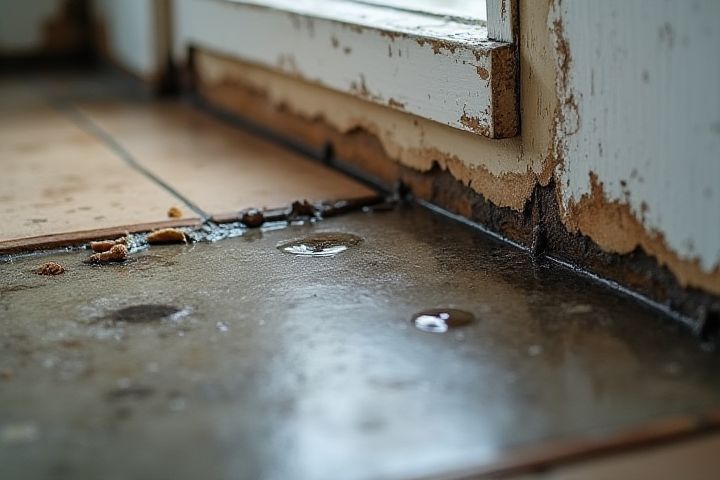
House leaks can arise from a variety of sources, such as damaged roofs, faulty gutters, or deteriorating plumbing systems. Roof leaks often occur due to missing shingles or cracks, allowing rainwater to infiltrate your living space. Gutters may overflow from debris accumulation, causing water to pool around your foundation and eventually seep inside. Additionally, plumbing issues, including broken pipes or worn-out seals, can contribute to water damage in walls and ceilings. To address leaks effectively, inspect these areas regularly and consider consulting with a professional for thorough repairs.
Why Is My House Leaking
Damaged or missing shingles
A common culprit behind house leaks is damaged or missing shingles, which compromise your roof's protective layer. Shingles can be affected by severe weather, age, or improper installation, leaving areas of your roof vulnerable to water intrusion. When just one square foot of roof is exposed, you risk significant water damage that can lead to costly repairs. Inspecting your roof regularly, especially after storms, can help you identify and address these issues before they escalate.
Cracked flashing
Cracked flashing can lead to significant water intrusion in your home, often manifesting as leaks in ceilings or walls during rainfall. This crucial component, typically made from metal or plastic, directs water away from vulnerable areas like chimneys, skylights, and roof eaves. Over time, environmental factors such as temperature fluctuations and extreme weather can cause flashing to become brittle or develop cracks, compromising its integrity. Inspect your flashing regularly to prevent costly repairs, as timely maintenance can save you from damage expenses that can exceed thousands of dollars.
Clogged gutters
Clogged gutters can lead to significant water damage in your home, as they prevent proper water drainage from the roof. When leaves, debris, and dirt accumulate in the gutters, they create blockages that cause water to overflow, potentially seeping into the walls and foundation. Regularly cleaning your gutters ensures that rainwater flows freely, protecting your roofing system and preventing mold growth inside your living spaces. If you notice leaks in your house, inspecting and maintaining your gutters should be a top priority to avoid costly repairs.
Poor roof installation
Poor roof installation can lead to significant water leakage, compromising your home's structure. If nails are improperly installed or missing, gaps can form, allowing rainwater to seep through. Inadequate sealing of roof joints and flashings can exacerbate the problem, leading to potential moisture damage. Regular inspections and hiring qualified professionals for installation can help prevent these costly issues.
Aging roofing materials
Aging roofing materials often degrade over time, leading to leaks and water damage in your home. Asphalt shingles, for instance, may show signs of wear after 20 to 30 years, while wooden shingles can warp or crack, reducing their effectiveness in waterproofing. The effects of weather exposure, such as UV rays and heavy rain, accelerate the deterioration process, creating vulnerable spots. Regular maintenance and inspection can help identify these issues early, potentially saving you from costly repairs and structural damage down the line.
Ice dam formation
Ice dams form when heat escapes from your home, melting snow on the roof that refreezes at the eaves, resulting in water pooling behind the dam. This trapped water can infiltrate your roofing system, causing leaks that may damage insulation, drywall, or even your home's foundation. Proper insulation and ventilation in your attic can mitigate this issue, as they help maintain a consistent roof temperature. Regularly clearing gutters and downspouts is also essential to prevent ice buildup and ensure proper drainage during colder months.
Condensation in attic
Condensation in your attic can lead to significant water leaks, often resulting from poor ventilation and temperature differences between your home interior and the attic environment. When warm, moist air rises from living spaces, it can collect on cooler surfaces, especially during colder months, creating excess moisture that condenses into water droplets. This water can accumulate and eventually find its way through ceilings or walls, damaging insulation and fostering mold growth, which poses health risks. To prevent condensation, ensure that your attic is properly ventilated using ridge vents or soffit vents, and consider installing vapor barriers to keep excess moisture at bay.
Poor attic ventilation
Poor attic ventilation can lead to various problems, including leaks in your house. When warm, moist air becomes trapped in the attic, it condenses on cold surfaces, causing water to accumulate and eventually leak through the roof. This situation is exacerbated when temperatures fluctuate, leading to ice dam formation in colder months, which further contributes to roof damage and leaks. Ensuring proper ventilation can lower attic temperatures by 10 to 20 degrees, reducing humidity levels and preventing structural damage to your home.
Worn sealant or caulking
Worn sealant or caulking is a common cause of leaks in your house, especially around windows, doors, and plumbing fixtures. Over time, exposure to weather conditions, temperature fluctuations, and UV light can degrade these protective barriers, leading to cracks and gaps. If you notice water stains or dampness near these areas, it's crucial to inspect and replace the compromised sealant; this can prevent further water damage and improve energy efficiency. Regular maintenance of your caulking can extend the lifespan of your home's exterior and keep leaks at bay.
Chimney or vent leaks
Chimney and vent leaks often occur due to improper sealing or deterioration of flashing, which can lead to water infiltration during heavy rain or snowfall. A 2017 study found that up to 20% of residential leaks originate from chimney and vent areas. Regular inspections can reveal cracked mortar joints, rusted flues, or damaged vents that compromise the integrity of your roof. Ensuring that these components are properly maintained can save you from expensive water damage repairs, potentially costing thousands.
